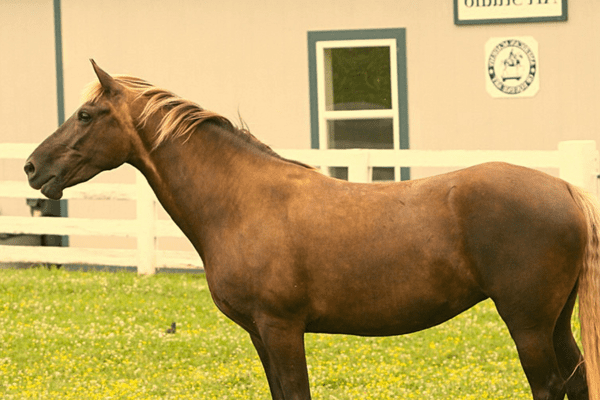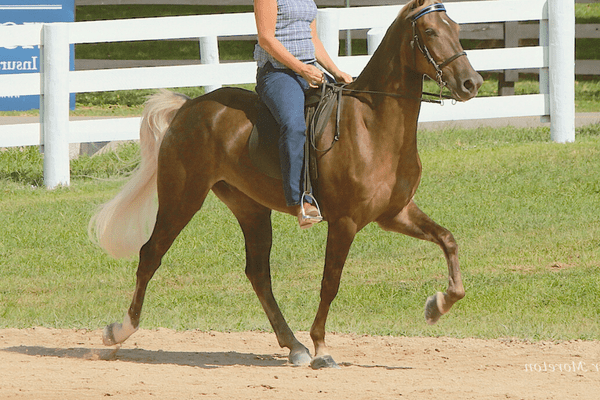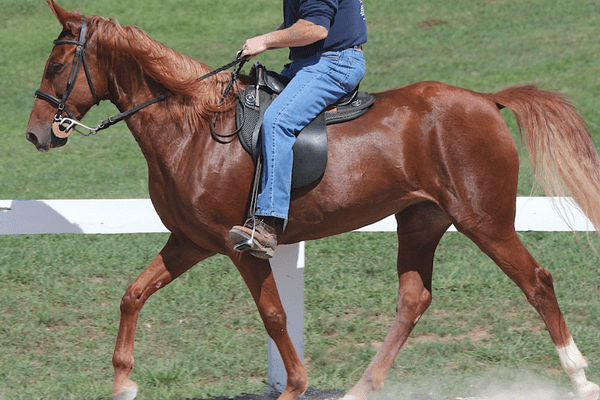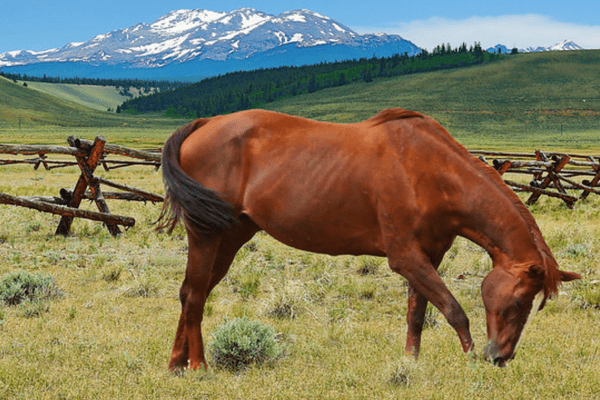The Rocky Mountain Horse breed hailing from the USA is renowned for its multipurpose abilities in riding, driving and light draft tasks. What sets them apart? Their gentle disposition and unique stride known as the single-foot gait – smoother than canter but faster than normal walk – which make them perfect for farm tasks and easy rides alike on rough terrain such as the Appalachians.
If you are seeking a reliable horse with an enjoyable experience then this breed should definitely be explored further.
History:
Origins and Bloodlines:
Epicenter of Evolution: Eastern Kentucky has long been recognized as a hotbed for horse breeding development; indeed it has given birth to several revered gaited breeds that remain popular today.
The Grand Fusion: To achieve the ideal blend, Southern Spanish horses were combined with resilient Northern English breeds in an intricate dance of genetics which resulted in American Saddlebreds, Tennessee Walking Horses and Missouri Fox Trotters being born from this marriage of beauty and strength.
Twins of History: When traveling through history together, Rocky Mountain Horse and Kentucky Mountain Saddle Horse often shared center stage. Both would proudly wear the title “Mountain Pleasure Horses”, signifying their common legacy.
Foundational Beginnings:
The Trailblazing Stallion: mes The Appalachians still tell tales of a particular stallion from the distant Rocky Mountains known as a Rocky Mountain Horse whose presence could be felt far across their region. Not only were its distinctive chocolate hue and flaxen mane iconic features; rather they carried stories and legacy that continues today.
Signature Gait: His distinct “single-foot” gait wasn’t just a means of movement; it became synonymous with him and would become one of his many distinct characteristics that would define subsequent generations of descendants.
Breeding Brilliance: By mating this stallion’s genes with those from local mares, Eastern Kentucky created an unparalleled horse strain – a mark of its equine prowess and symbol of pride for this region.
Old Tobe’s Legacy:
Carrying the Torch Forward: Carrying Forward the Torch As time progressed, Old Tobe, an direct descendant of the pioneering stallion, assumed responsibility for shaping the breed’s modern identity.
Steward of the Breed: Sam Tuttle was not just an owner; he served as an advocate for this breed’s heritage from Spout Springs, Kentucky, guiding it through turbulent waters during both World Wars.
Longevity and Lineage: Old Tobe was not only remarkable for his breeding feats; his outstanding lifespan of 37 years stands as proof of the breed’s robust constitution.

Genetic Connections and Evolution:
Ancestors Speak: The Narragansett Pacer remains an elusive figure; its indomitable gaited spirit may have even crept its way into Rocky Mountain Horse’s genetic code.
Guardians of the Breed: Since 1986, when the Rocky Mountain Horse Association first opened their doors with 26 registrations, their efforts have paid off with over 24,000 registrations as of 2015.
The Gold Standard: To ensure the breed remains pure, stringent checks, including DNA verifications and gait evaluations have become required to maintain its pedigree.
Present Day and Beyond:
Renaissance Horse: Riding Horses to Plow Fields and Herd Cattle for Transport in Appalachia for centuries was like using an indispensable Swiss Army knife on farms – plowing fields, herding cattle, providing transport.
Celebrating Excellence: An annual spectacle, the International Rocky Mountain Horse Show at Kentucky Horse Park, stands as an ode, celebrating the breed’s legacy, resilience, and unparalleled grace.
Breed Characteristics:
Physical Characteristics:
The Rocky Mountain Horse is an elegant breed that typically stands between 14-16 hands high, exuding robust athleticism. Though they come in all coat colors, Rocky Mountain Horses are most frequently recognized by their striking “chocolate” shade with flaxen mane and tail – not by mere chance but because it is due to the rare silver dapple gene’s effect upon black base coats; making the Rocky Mountain Horse part of an exclusive genetic club.
Genetics and Health:
Genetics can reveal some fascinating insight when applied to Rocky Mountain horses. Their signature silver dapple gene not only contributes to their unique coloration but may also hold important indications as to their wellbeing. Preliminary research indicates a genetic predisposition towards multiple congenital ocular anomalies (MCOA). Preliminary findings point towards an association between this condition and silver dapple gene mutations and this predisposition.
To explore further into this genetic story, a 2017 report entitled “Microphthalmia with Multiple Ocular Abnormalities in 11 Horses: a Novel Syndrome” revealed an assortment of abnormalities which comprised an entirely new syndrome characterized by microphthalmia in 11 horses. This revelation underlines the significance of continued genetic research into equine health.
Temperament and Abilities:
One cannot discuss Rocky Mountain Horses without noting their incredible resilience and adaptability. These horses have managed to adapt and survive even the harshest winter conditions, which is testament to their resilience and perseverance. But their physical endurance is only half the story; their temperament also deserves praise – they form close ties with humans making them excellent companions.


Gait and Mobility:
The Rocky Mountain Horse stands out among other breeds by possessing an unusual locomotion pattern, distinguishing it from others of its breed. Instead of the regular trot seen with most breeds, its Rocky Mountain counterpart is revered for its natural ambling gait known as single-foot.
This four-beat gait offers riders an exceptional smooth experience, as the horse maintains consistent ground contact to reduce jolts and jerks. This biomechanical advantage enables Rocky Mountain Horses to move efficiently over uneven terrain at an average speed of 7 miles per hour while quickly accelerating on smoother surfaces up to 16 mph – commonly referred to as “racking”. Other horses typically trot at 6-8 miles per hour compared with this exceptional gait advantage enjoyed by Rocky Mountain Horses.
Uses of Rocky Mountain Horse:
The Rocky Mountain Horse has unique characteristics and capabilities that allow it to excel in various roles that take advantage of its unique qualities. Some primary uses for this versatile breed include:
Trail Riding: These horses’ distinctive, ambling gait known as single-foot is ideal for long distance trail rides, making these breeds popular with trail riders. Furthermore, their sure footedness and calm temperament make them the perfect partners in navigating varied terrains such as mountain paths or forest trails.
Show Ring: In competitive arenas, Rocky Mountain Horses excite audiences with their natural gait, poise, and stunning appearance; particularly its signature chocolate coat featuring flaxen mane and tail.
Endurance Riding: Their robust constitution and stamina make them well suited to endurance riding, while their efficient gait allows them to cover long distances at a steady speed.
Working on the Ranch/Farm: These horses have historically been bred for utility and perform various duties around a farm or ranch, such as herding cattle or light plowing work. Their collaborative nature and eagerness to work make them reliable partners in daily operations.
Therapeutic Riding: Due to their gentle temperament and steady gait, horses with breed characteristics such as those seen here make ideal candidates for therapeutic riding programs, providing physical and emotional support to people living with disabilities.
Pleasure Riding: Rocky Mountain Horses make ideal companions for casual riders due to their friendly, low maintenance needs and ability to adapt easily in various living situations, which makes them an appealing option for first-time horse owners.
Driving: Beyond riding, these horses are also trained for competition- and leisure carriage driving. Their strength and stable temperament make them suitable for both high-pressure competitive environments and relaxing countryside excursions.
Family Horse: Trained to be calm and trainable, family horses make ideal family horses. Perfect for riders of various ages and skill levels.Rocky Mountain Horses are well-loved family members due to their reputation of loyalty and affectionate personality.
Rocky Mountain Horses stand out in each role they fill, not only due to their physical abilities but also for their exceptional temperament and exceptional versatility. Equestrians around the world appreciate these horses for their welcoming nature; whether on a relaxing trail ride, bustling ranch worksite or therapeutic comfort services they perform their roles with unmistakable grace and steadfast spirit.


Conservation Efforts:
Unfortunately, Rocky Mountain Horse numbers decreased dramatically throughout the 20th century. To recognize their cultural and biological importance, in 1986 the Rocky Mountain Horse Association was created; their dedicated efforts combined with those of breed enthusiasts have played an essential role in conserving this endangered and highly-valued breed.

